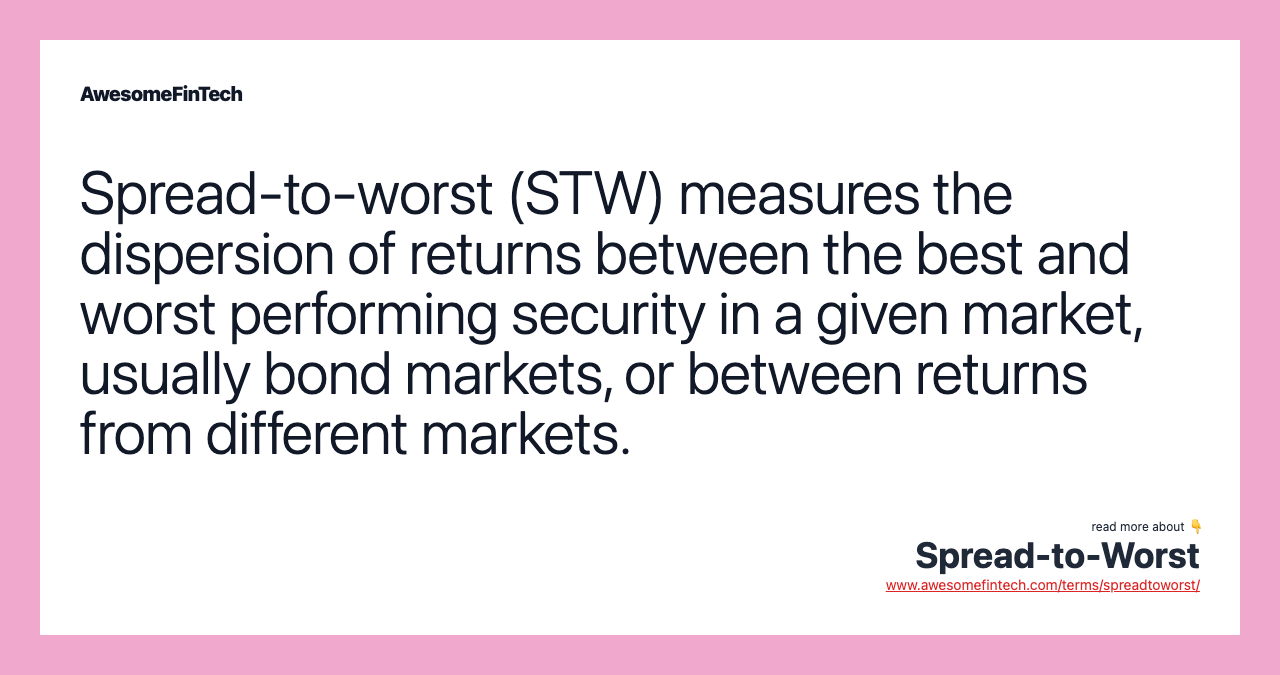Spread-to-Worst
Spread-to-worst (STW) measures the dispersion of returns between the best and worst performing security in a given market, usually bond markets, or between returns from different markets. STW in bond markets is the difference between the yield-to-worst (YTW) of a bond and the yield-to-maturity (YTW) of a U.S. Treasury security with similar duration. Applying spread-to-worst to different markets can guide an investor in making decisions that could optimize their portfolio's value. STW in bond markets Spread-to-worst (STW) measures the dispersion of returns between the best and worst performing security in a given market, usually bond markets, or between returns from different markets. Spread-to-worst (STW) measures the dispersion of returns between the best and worst performing security in a given market, usually bond markets, or between returns from different markets. Suppose a callable high-yield bond is issued with a 10-year maturity and a five-year non-call protection provision (i.e., the issuer is not allowed to redeem the bond within five years).

What is Spread-To-Worst?
Spread-to-worst (STW) measures the dispersion of returns between the best and worst performing security in a given market, usually bond markets, or between returns from different markets.



Understanding Spread-To-Worst (STW)
STW in bond markets is the difference between the yield-to-worst (YTW) of a bond and yield-to-worst of a U.S. Treasury security with similar duration. The STW is either yield-to-call (YTC) or yield-to-maturity (YTM), whichever is lower, and is expressed in "basis points (bps)."
STW uses the YTW, which is the lowest potential yield that can be received on a bond without the issuer actually defaulting. If a bond is callable, an investor runs the risk of lower returns from the bond. This is because, in an environment of declining interest rates, the bond investor would have to reinvest in lower-yielding fixed income securities. Corporate bonds and municipal bonds typically have call provisions.
A bond's YTW is calculated on all possible call dates prior to maturity. It is assumed that a prepayment occurs if the bond has a call option and the issuer can reissue at a lower coupon rate. The YTW is the lower of YTC or YRM. YTC is the annual rate of return assuming the bond is redeemed by the issuer on the next call date. The YTW of a premium bond is equivalent to YTC because the bond issuer is likely to call it. A bond trading at a premium means the coupon rate is above the market yield.
Applying STW to different markets can guide an investor to make decisions that could optimize their portfolio's value. For example, if STW between equities and U.S. treasuries was high, say over 40%, then the investor might consider skewing their portfolio's weighting towards equities. As is the case with most market reactive measures, STW will is heavily dependent on variables such as short- or long-term interest rates, investor confidence, and other similar metrics.
Special Considerations
Figuring out which is is lower can be done quickly by understanding some tips. First, if a bond is callable then there will be a YTC. If not, YTM is the de facto lowest yield and will be used for STW. However, if the bond is callable and it trades at a premium to par value, the YTC will be lower than YTM.
Callable bonds are most likely called when interest rates are low. The yield on callable bonds is typically higher because of the risk that investors will have to reinvest the proceeds at a lower interest rate, also known as reinvestment risk.
Example of Spread-to-Worst (STW)
Suppose a callable high-yield bond is issued with a 10-year maturity and a five-year non-call protection provision (i.e., the issuer is not allowed to redeem the bond within five years). After three years, interest rates are lower, which means there is potential for the issuer to call the bond in order to refinance at a lower coupon rate.
The bond that the investor owns is now trading at a premium. The YTC is compared to the yield of a two-year Treasury — five years of non-call protection minus the three years that have lapsed. The difference is the STW, expressed in basis points.
Related terms:
Basis Points (BPS)
Basis points (BPS) refers to a common unit of measure for interest rates and other percentages in finance. read more
Bond : Understanding What a Bond Is
A bond is a fixed income investment in which an investor loans money to an entity (corporate or governmental) that borrows the funds for a defined period of time at a fixed interest rate. read more
Bond Market
The bond market is the collective name given to all trades and issues of debt securities. Learn more about corporate, government, and municipal bonds. read more
Callable Security
A callable security is a security with an embedded call provision that allows the issuer to repurchase or redeem the security by a specified date. read more
Callable Bond
A callable bond is a bond that can be redeemed (called in) by the issuer prior to its maturity. read more
Call Risk
Call risk is the risk faced by a holder of a callable bond that a bond issuer will redeem the issue prior to maturity. read more
Dispersion
Dispersion is a statistical measure of the expected volatility of a security based on historical returns. read more
Fixed Income & Examples
Fixed income refers to assets and securities that bear fixed cash flows for investors, such as fixed rate interest or dividends. read more
High-Yield Bond
A high-yield, or "junk" bond has a lower credit rating and thus pays a higher yield due to having more risk than higher rated bonds. read more
Municipal Bond
A municipal bond is a debt security issued by a state, municipality or county to finance its capital expenditures. read more